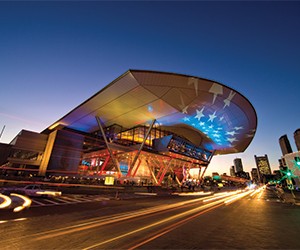Medical meetings today are difficult to diagnose. Austerity is in, and new restrictions on gifts and sponsorship—as well as increased transparency in funding—has cut into the lavish giveaways and luxurious venues that were once seen as hallmarks of such events.
At the same time, overall attendance at medical meetings continues to climb. According to the Healthcare Convention & Exhibitors Association (HCEA), attendance at the industry’s top 50 events surpassed pre-recession levels in 2010 and 2011 and continues to grow. For every dismal report in the HCEA Top 50 meetings such as Digestive Disease Week (down 10.3 percent) there are multiple increases such as the American Association for Cancer Research event (up 19.8 percent), Pittsburgh Conference on Analytical Chemistry & Applied Spectroscopy (up 15.5 percent) or the American Urological Association annual function (up 12.8 percent).
Top medical meeting destinations are growing to meet the demand. Some cities, including Chicago, are expanding existing hotel or convention center facilities. Other cities, such as New Orleans, are creating entirely new healthcare complexes that include meeting space. And some cities, like Cleveland, have done both. Here’s a quick look at how seven key medical meeting hubs are meeting new demand.
Boston
Boston has been a medical powerhouse since Harvard Medical School was founded in 1782. The Boston Convention and Exhibition Center (BCEC), is a constant on many a medical meeting rotation schedule. And Boston wants to keep it that way.
A $1 billion BCEC expansion, approved last summer, will add 1.3 million square feet and more than double the center’s usable space. The extra space should open the door to ever-larger medical events that now head for mega-facilities in Chicago, Las Vegas and Orlando. Massachusetts Convention Center Authority (MCCA) Executive Director James Rooney says the expanded BCEC will turn Boston into a top-five convention market.
MCCA and the Boston Port Authority are also moving forward on a new 1,200-room headquarters hotel near the expanded BCEC. The new property is in addition to a 500-room development with Aloft and Element properties that broke ground in December. Boston already has more than 30,000 hotel rooms and expects to add at least 3,000 new rooms by 2017.
Chicago
Heading Cvent’s latest list of Top 50 Meeting Destinations in the U.S., Chicago is a longstanding hub of medical events. That status will only be boosted by this month’s debut of Matter, a dynamic new health technology space at the massive Merchandise Mart. Also, the Metropolitan Pier and Exposition Authority (MPEA) will break ground on a second 1,200-room headquarters hotel and 10,000-seat McCormick Place Event Center during the second quarter of this year.
That new development is across the street from McCormick Place West and includes the first Marriott Marquis in Metro Chicago. Planners get 40,000 square feet of new meeting space in the Marriott, plus two 25,000-square-foot ballrooms.
The Event Center, which will serve as home court for DePaul University basketball, will also be available for general sessions as well as concerts and other special events. The project includes renovation of the historic American Book Company building, plus pedestrian bridges connecting the hotel and event center to each other and to existing McCormick Place space.
Cleveland
Once a rustbelt manufacturing hub, Cleveland has evolved into an epicenter for medical innovation and technology. When the city created its new Cleveland Convention Center in 2014, the medical meetings community got its own Global Center for Health Innovation, typically better known as the Medical Mart.
The four-story Global Center is officially part of the 225,000-square-foot Cleveland Convention Center, but has its own 11,000-square-foot junior ballroom as well as smaller event spaces throughout the health-related display floors.
PageBreak
Each level has its own theme: Health and Home on the first floor; People, Patients and Caregivers on the second floor; Clinical Spaces on the third floor; and Health Care Information Technology on the fourth floor.
Most of the spaces feature single-vendor showrooms with an emphasis on technology-based products, a natural with more than 200 health tech-based companies in the area. Multivendor areas have been chosen based on their relevance to contemporary health care delivery such as IT, views to the future and educational spaces. And it doesn’t hurt to have more than 4,000 hotel rooms within walking distance.
New Orleans
NOLA moved up to the No. 9 spot on Cvent’s Top 50 list for 2014, fueled by a growing list of hotel improvements and the still-expanding BioDistrict New Orleans.
What used to be the Cotton Exchange Hotel emerged as the AC Hotel New Orleans Bourbon in October 2014. The new property offers 220 European-styled rooms and is the first AC Hotel, part of Marriott’s European portfolio, in the U.S.
The former W Hotel debuted as a Le Meridien in December with more than 13,000 square feet of meeting space. A $29 million renovation finishes this spring.
Also new this spring is the Aloft New Orleans Downtown. The property has just 3,600 square feet of meeting space for its 188 rooms, but the four small rooms are outfitted as boardrooms with the latest AV technology and 50-inch plasma screens to make training videos pop.
The $3.3 billion BioDistrict New Orleans spans 1,500 downtown acres devoted to medicine, health care and bioscience. Facilities include health science centers for both Tulane and Louisiana State universities. Planners pay most attention to the 68,000-square-foot New Orleans Bioinnovation Center, a combination incubator for health and bioscience companies and convention complex.
Orlando
Orlando has long been battling Chicago for the top spot on the Cvent Top 50 list.
The city’s not-so-secret weapon for luring medical meets is Lake Nona, a planned community that includes a 650-acre Medical City. Just 11 miles from the Orange County Convention Center, Medical City is already home to a half-dozen world-class facilities: MD Anderson Orlando Cancer Research Institute; Nemours Children’s Hospital; Sanford-Burnham Medical Research Institute; University of Central Florida Health Sciences Campus; University of Florida Academic & Research Center; and a new VA Medical Center. Medical City has emerged as one of the newest and fastest-growing life sciences innovation centers in the country. All of the new facilities have meeting and event space.
Equally important for planners with tight budgets, all six facilities come equipped with world-renowned clinicians and researchers who can help headline presentation schedules without racking up major travel expenses.
San Diego
San Diego is already one of America’s top five medical meeting cities. The Southern California city is on the rotation for more than 50 major medical events, on par with Boston and Chicago; both have more event space, but San Diego has them beat for weather conditions and overall innovation.
Jonas Salk, inventor of the first polio vaccine in the 1950s, deserted Pittsburgh for San Diego when he established the Salk Institute for Biological Studies. Dozens of other luminaries and biomedical entrepreneurs were also drawn. Most settled on Torrey Pines Mesa in La Jolla, now home to a University of California campus, Scripps Institute, General Atomics, Sanford-Burnham Medical Research Institute and a long list of medical technology innovators.
Pharma giant Pfizer has a particularly robust presence, with a 25-acre campus showcasing 500,000 square feet of facilities.
“The Mesa just adds to the reasons planners and companies choose San Diego for their medical meetings,” says San Diego Tourism Authority President Joe Terzi.
San Francisco
San Francisco is already a favorite with medical event planners. Such a fave that space is tough to find. Enter the Mission Bay Conference Center (MBCC), which contains 12,500 square feet of meeting and event space on the University of California San Francisco campus at Mission Bay.
“We’re not a major convention center and we’re not a hotel,” says General Manager Mark Wallace. “We’re a medical school with five Nobel laureates on faculty. Any planner who wants to ride those coattails, we’re there.”
Not having hotel space is both a plus and a minus. It’s tougher than meeting in a hotel for out-of-town attendees, though there is no lack of convenient hotel space nearby. And it’s a huge step up from meeting in a hotel, for privacy and security purposes.
MBCC’s presence has also stepped up its locale. Once a derelict industrial district, Mission Bay is quickly evolving into a 24/7 neighborhood with the UC campus, three new hospitals, a new sports arena, medical tech workspaces and more new restaurants than local reviewers can keep track of.
Fred Gebhart has covered a wide variety of industy topics for Meetings Focus.






